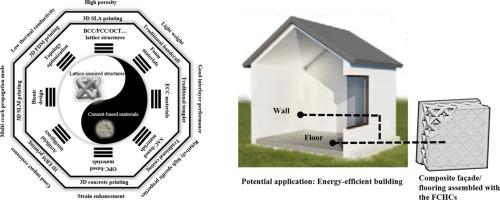当前位置:
X-MOL 学术
›
Autom. Constr.
›
论文详情
Our official English website, www.x-mol.net, welcomes your feedback! (Note: you will need to create a separate account there.)
3D face-centered-cubic cement-based hybrid composites reinforced by tension-resistant polymeric truss network
Automation in Construction ( IF 10.3 ) Pub Date : 2020-12-01 , DOI: 10.1016/j.autcon.2020.103380 Lixiao Li , Junying Chen , Xiaowen Tan , Yizhuo Zhou , Yang Zhang , Wenzhao Zhou , Ran Xiao , Xiang Li , Yang Lu , Mayni Su , Zhu Ding , Wujian Long , Jian Song
Automation in Construction ( IF 10.3 ) Pub Date : 2020-12-01 , DOI: 10.1016/j.autcon.2020.103380 Lixiao Li , Junying Chen , Xiaowen Tan , Yizhuo Zhou , Yang Zhang , Wenzhao Zhou , Ran Xiao , Xiang Li , Yang Lu , Mayni Su , Zhu Ding , Wujian Long , Jian Song

|
Abstract After 30 years of development, 3D printing technology (3DPT) is becoming increasingly popular in civil engineering field. However, weak interlayer performance and lack of reinforcement significantly limit its application. Nowadays, structural-functional integrated energy-efficient building materials, theoretically requiring a balance of mechanical properties and thermal resistance, are an emerging interdisciplinary research area in civil engineering field. This work proposed a novel digital cement-based manufacture technology by integrating 3D printing technology with casting technology. By incorporating tension-resistant polymeric truss network (PTN), a category of 3D face-centered cubic-inspired cement-based hybrid composites (FCHCs) is proposed. Results show the printed PTN can effectively improve the tension-resistant capacity of cement mortar. The FCHCs not only exhibit a multiple cracking damage characteristic but also a low thermal conductivity compared to traditional cement-based materials. A building energy simulation program was performed to evaluate the effectiveness of FCHCs on the energy savings. It is found that 34% heating energy could be saved for FCHCs building.
中文翻译:

由抗拉聚合物桁架网络增强的 3D 面心立方水泥基混合复合材料
摘要 经过30多年的发展,3D打印技术(3DPT)在土木工程领域越来越受欢迎。然而,弱的夹层性能和缺乏增强显着限制了它的应用。目前,结构功能一体化节能建筑材料在理论上需要兼顾力学性能和耐热性,是土木工程领域一个新兴的跨学科研究领域。这项工作通过将 3D 打印技术与铸造技术相结合,提出了一种新型的数字水泥基制造技术。通过结合抗拉聚合物桁架网络 (PTN),提出了一类 3D 面心立方启发水泥基混合复合材料 (FCHC)。结果表明,印刷PTN能有效提高水泥砂浆的抗拉能力。与传统的水泥基材料相比,FCHCs 不仅表现出多重开裂损伤特性,而且导热系数低。执行建筑能源模拟程序以评估 FCHC 对节能的有效性。结果表明,FCHC 建筑可以节省 34% 的热能。
更新日期:2020-12-01
中文翻译:

由抗拉聚合物桁架网络增强的 3D 面心立方水泥基混合复合材料
摘要 经过30多年的发展,3D打印技术(3DPT)在土木工程领域越来越受欢迎。然而,弱的夹层性能和缺乏增强显着限制了它的应用。目前,结构功能一体化节能建筑材料在理论上需要兼顾力学性能和耐热性,是土木工程领域一个新兴的跨学科研究领域。这项工作通过将 3D 打印技术与铸造技术相结合,提出了一种新型的数字水泥基制造技术。通过结合抗拉聚合物桁架网络 (PTN),提出了一类 3D 面心立方启发水泥基混合复合材料 (FCHC)。结果表明,印刷PTN能有效提高水泥砂浆的抗拉能力。与传统的水泥基材料相比,FCHCs 不仅表现出多重开裂损伤特性,而且导热系数低。执行建筑能源模拟程序以评估 FCHC 对节能的有效性。结果表明,FCHC 建筑可以节省 34% 的热能。


























 京公网安备 11010802027423号
京公网安备 11010802027423号